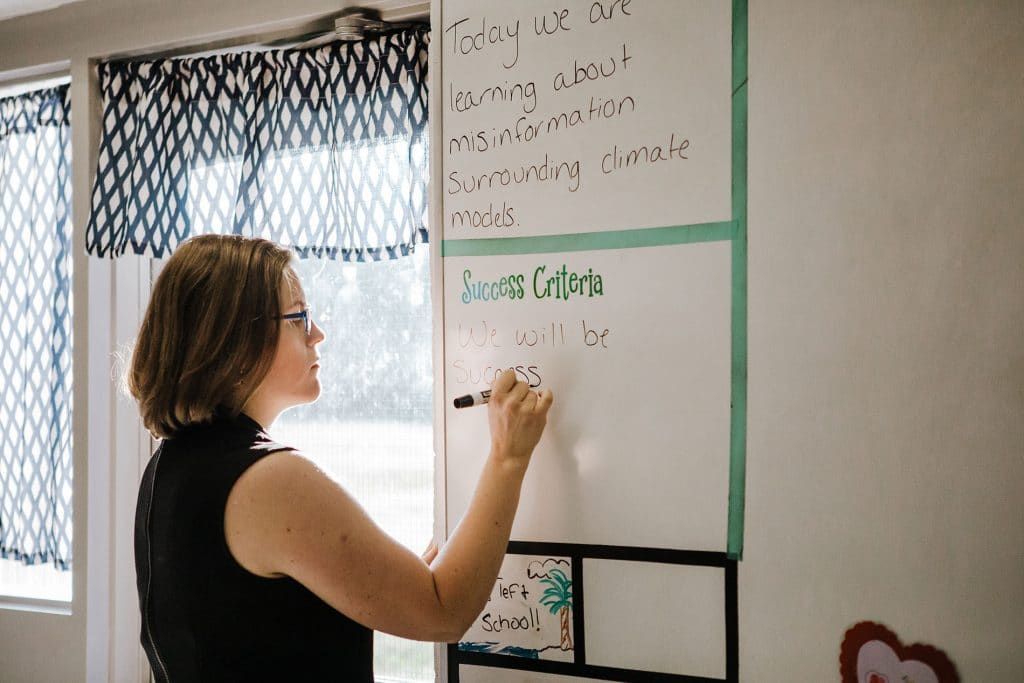America is too often failing students on climate change
By Ann Reid, Val Benavidez | February 2, 2021
 Middle school science teacher Sarah Ott at the whiteboard for her climate science class in Dalton, Georgia. Ott is a "teacher ambassador," who works with her peers to ensure more students have access to effective, evidence-based lessons about climate change. All images courtesy of National Center for Science Education.
Middle school science teacher Sarah Ott at the whiteboard for her climate science class in Dalton, Georgia. Ott is a "teacher ambassador," who works with her peers to ensure more students have access to effective, evidence-based lessons about climate change. All images courtesy of National Center for Science Education.
Americans want their children to learn about climate change in the public schools. More than three in four of us agree that schools should teach about the causes, consequences, and potential solutions to global warming.
So why isn’t it happening?
The main influence on what’s taught in the classroom is state science standards, which specify what knowledge and abilities students are expected to acquire in the course of their education. These standards affect the content of textbooks, statewide testing, and teacher preparation.
But the treatment of climate change in their science standards varies drastically in quality, according to a recent report from the National Center for Science Education and the Texas Freedom Network Education Fund—even though all states are already experiencing the disruptions of climate change,
For the report, available at ClimateGrades.org, a panel of scientists reviewed standards for all 50 states plus the District of Columbia, focusing on how well the standards address four key points central to the scientific consensus on climate change: It’s real; it’s us; it’s serious; there’s hope.
Unfortunately, the results of the report are disturbing.
Although there are bright spots—a majority of states managed to earn a grade of “B+” or better—ten states received a “D” or worse, including some of the most populous states in the country, such as Florida, Ohio, Pennsylvania, and Texas. The worst of the standards failed to recognize—or even outright denied—that the existence, causes, and effects of climate change are a matter of overwhelming scientific consensus. (Ninety-seven percent of climate scientists agree that humans are the main cause of global warming.) West Virginia’s standards actually require students in high school environmental science classes to debate the reality of climate change in the classroom.
Elsewhere, climate change is ignored altogether, or not described forthrightly, or is misleadingly described as hypothetical. Alabama’s standards suggest that human activities “may have caused” a rise in global temperatures
There’s no “may” about it: human activities have caused it, and they continue to do so.

Even in states where the standards acknowledge the reality of climate change, the report observed, there is often a failure to convey the message that “there’s hope” in ways of mitigating and adapting to the disruptive effects of climate change on nature and society.
So there’s room for improvement, obviously. Pennsylvania, South Carolina, and Texas are all in the process of revising their state science standards. Since their current standards all received an F in the recent report, at least a degree of improvement seems likely there.
But improvement is needed in general. Even states with a good treatment of climate change in their existing science standards can, and should, look for ways of improving the quality and quantity of climate change education in their public schools. For example, New Jersey recently incorporated climate change across its state education standards, providing opportunities for teachers to discuss the issue with their students where appropriate in practically any of their classes. And over the last few years legislation has been introduced in a number of states, including Minnesota, New Jersey, New York, and Washington, to ensure that teachers are equipped with the content knowledge and pedagogical know-how they need to teach climate change effectively.
And don’t think that it’s only in true-blue states that efforts to improve climate change education can succeed. Among the states with the best treatment of climate change in their science standards, according to the National Center for Science Education and the Texas Freedom Network Education Fund report, were the ruby-red Alaska, North Dakota, and Wyoming.
The purpose of public education is to prepare today’s students to flourish in the world they will inherit tomorrow. That is incontrovertibly going to be a warmer world.
So we can—and must—do a better job when it comes to teaching climate change in our public schools.
Together, we make the world safer.
The Bulletin elevates expert voices above the noise. But as an independent nonprofit organization, our operations depend on the support of readers like you. Help us continue to deliver quality journalism that holds leaders accountable. Your support of our work at any level is important. In return, we promise our coverage will be understandable, influential, vigilant, solution-oriented, and fair-minded. Together we can make a difference.
Keywords: Climate change education, climate change, climate crisis, climate science, global warming
Topics: Climate Change
















Although I appreciate your point, please acknowledge that schools only have students within their spheres of influence for 15% of those kids’ K-12 lives. Everyone has *something* they think “schools should be doing” despite the fact that every state already has multiple standards which must be met. Yes, climate change can – and very often is, despite your claim that “it isn’t happening” – be incorporated into many of those standards, but it is still not necessarily going to counter the information they get from family, friends, social media, community, church, and other sources during the other 85% of their… Read more »
I’d be interested in thinking about this problem with respect not only to K-12 schools, but also to higher education. Of course, university students who already have a strong interest in climate change can typically find relevant courses and majors. But what about students with other sorts of majors? What about students in professional schools (law, business, medicine, …)? Shouldn’t we be finding ways to engage them in issues of climate change — both as directly and as indirectly related to their chosen area of focus — as well?